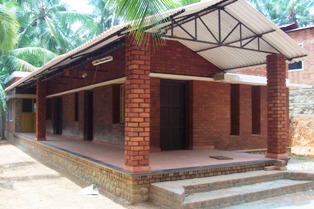
About Handloom Weavers Development Society
Headquartered in Balaramapuram, Kerala (Southern India), the Handloom Weavers Development Society (HLWDS) is a non-governmental organization that works to improve the welfare of deprived, marginalized and downtrodden handloom weaving communities in Kerala.
Across India, handloom weavers live in abject poverty earning approximately 70 rupees a day (around $2 a day). For the last 13 years, HLWDS has undertaken livelihood activities that aim to strengthen the income earned by handloom weavers through training, marketing and value-added techniques such as dyeing and embroidery. Through these efforts, HLWDS program participants earn about up to Rs. 140 a day (around $4 a day), more than double the wage earned by non-HLWDS weavers.
HLWDS also works to overcome gender issues through women empowerment programs that allow women to overcome exploitative master weavers and break the cycles of debt. For more information on our programmes, please visit the programmes section of our website.
| Vision:A flourishing handloom weaving industry preserving Indian culture and providing a decent standard of living to weaver families. Mission:To provide employment to weaver families in Kerala through providing looms and associated services, so that they can enjoy a better standard of living and preserve their heritage and culture. |
History
The Handloom Weavers Development Society was established in 1989 by a group of twenty four young weavers from the Balaramapuram area of the district of Thrivandrum, Kerala. The invention of the power loom, the recurrence of sweatshop manufacturing and a competitive global textile market was stripping handloom weavers of their market. These young weavers organized to discuss ways to overcome the plight of the handloom weaving sector and to put an end to the oppressive labor arrangements and corruption that was occurring in the sector.
In 1994, HLWDS established 30 livelihood and self-help groups (SHGs). SHGs are the main conduit for the majority of our programming. The SHGs are semi-autonomous savings and credit organizations that also function as a support network to address weaving and social issues such as occupation health hazards, child labor and women’s empowerment. Today, there are 731 SHGs in 58 villiages operating under the auspice of HLWDS.
With the assistance of a five-year grant from the Ford Foundation, HLWDS has made significant strides in its long-term goal of diversifying handloom production. HLWDS has successfully piloted several training programs in alternative hand produced textile techniques including new designs, block printing, batik, tie and dye, kalamkari, and ayurvedic dyeing.
Our experimentation with ayurvedic dyeing has been one of our most successful product diversification initiatives. With the financial support of the Government of Japan, HLWDS established an ayurvedic dye house in Balaramapuram, which was inaugurated by MR. RIYOZU KIKUCHI, Consul General of Japan on 7th September 2004. The ayurvedic dye house is equipped with modern machineries and facilities to produce pure ayurvedic herbal handloom clothes. The minimum production capacity of our dye house is nearly 1000kg per day. Also in 2005, the Government of India generously granded Rs. 850,000 to assisted the HLWDS establishing a common facility centre for ayurvedic dyeing on handloom clothes and to standardization ayurvedic dyeing.

Timeline
- 1989 HLWDS established
- 1991 Founding member Handloom Protection Forum
- 1994 Livelihoods programs and Self Help Groups started
- 1994 Started showroom for handloomed products
- 1995 Founded South Indian Handloom Weavers Organizing Committee (SIHWOC)
- 1998 First Internal Learning System (ILS) diaries implemented
- 1998 Initiated training programs on technical skills
- 2004 Established Yarn Bank
- 2004 Established Legal Aid Center
- 2004 Built Auyervedic Dye Shed
- 2004 Started business-to-business meetings
- 2005 Developed MEDICINAL CLOTH brand.
- 2006 Built Finishing facility - embroidery, sewing, packaging